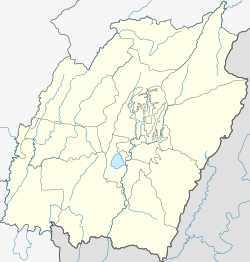
Imphal is the capital city of the Indian state of Manipur. It is the second largest city in northeast India after Guwahati & Agartala. The metropolitan centre of the city contains the ruins of Kangla Palace, the royal seat of the former Kingdom of Manipur, surrounded by a moat. Spread over parts of the districts of Imphal West and Imphal East, the former contains the majority of the city's area and population. Imphal is part of the Smart Cities Mission under the Ministry of Housing and Urban Affairs. Being a mega commercial hub, Imphal is known for its weaving, brass-ware, bronze-ware, and other cottage industries. Meitei language is the most widely spoken language in the city.

Moirang is a town in the Indian state of Manipur, best known for the tentatively listed UNESCO World Heritage Sites of the Keibul Lamjao Conservation Area (KLCA), covering Keibul Lamjao National Park (KLNP), the world's only floating national park, the buffer of Loktak Lake and Pumlen Pat. It is best known for the being the place of origin of the ancient epic legend of Khamba and Thoibi, one of the seven epic cycles of incarnations of Meitei mythology and folklore. Nationwide, it is also famous for the INA War Museum in the INA Martyrs' Memorial Complex, where Colonel Shaukat Malik of the Indian National Army hoisted the Tricolour for the first time on Indian soil on 14 April 1944. It is situated approximately 45 km (28 mi) south of the state capital Imphal. It has an area of 269 km2 (104 sq mi) with a population of 62,187 in 67 villages. There are 12 Panchayats in this block.
Kakching is a town in the southeastern part of the Indian state of Manipur. It serves as the headquarters of Kakching district and is a major commercial hub in the state. In 2018, Kakching was declared as the cleanest city in North East India by the Swachh Bharat Mission of the Indian government.

Bishnupur district or Bishenpur district, is a district of Manipur state in northeastern India.
Kakching Khunou is an agricultural town in Kakching district in Manipur, India. Situated at a distance of 56 km from Imphal, it is surrounded by hillocks and agricultural land. Tarang Turel, a rivulet flowing down from the eastern hills, runs through the middle of the town serving as a natural spring. It is connected to other parts of the state by the Imphal -Sugnu state highway.
Ningthoukhong is a town and a Municipal Council having 14 wards in Bishnupur district in the Indian state of Manipur.
Mukna is a form of folk wrestling from the north-east Indian state of Manipur. It is popular in Imphal, Thoubal and Bishnupur. The game is generally played on the last day of the Lai Haraoba festival and is an intrinsic part of the ceremonial functions.

Lai Haraoba is a traditional Meitei religious festival of ritual dance and musical theatre, celebrated annually in honour of Umang Lais, the forest deities of Sanamahism.
Toubul is a village in the Bishnupur district of Manipur, India, with a total population of around 4044 people as per the 2001 census. The village is surrounded by farmlands in the west, north, and south, and by Loktak Lake in the east. Farming and fishery are the main sources of livelihood for the residents. However, Toubul is also one of the most affected villages due to the hydroelectric power generation plant from Loktak lake, which happens to be the biggest freshwater lake in north-east India.
Elam Endira Devi, is an Indian classical dancer and teacher, known for her expertise and scholarship in the classical dance form of Manipuri, especially in the genres of Lai Haraoba and Raas. The Government of India honored her, in 2014, with the Padma Shri, the fourth highest civilian award, for her services to the field of art and culture.
Khangembam Mangi Singh, popularly known as Guru Pena Mangi, was an Indian musician, known for his expertise on the Manipuri traditional musical instrument Pena. The Government of India honored him in 2011, with the fourth highest civilian award of Padma Shri.
Haobam Ongbi Ngangbi Devi was an Indian classical dancer and musician, known for her expertise in the Manipuri Dance forms of Lai Haraoba and Raas. In 2010, the Government of India awarded Haobam Ongbi Ngangbi Devi the Padma Shri, the fourth highest Indian civilian award.

Northeast India consists of eight states: Arunachal Pradesh, Assam, Manipur, Meghalaya, Mizoram, Nagaland, Sikkim and Tripura. Tourism in this area is based around the unique Himalayan landscape and culture distinct from the rest of India.
Wangoo is a village in the Kakching district of the Indian state of Manipur. It is situated approximately 64 km south of the state capital, Imphal. It has an area of 13.05 km2 with a population of 6134.
Khoijuman is a small village situated within the Bishnupur district in the Indian state of Manipur. It is located about 30 km (19 mi) to the south of Imphal. It has population of about 3000 (approx) with 1460 are males and 1490 are females.

Umang Lai are deities in Sanamahism who are the local guardians of a neighborhood or particular area. Umang Lais are worshipped only two times in a year. They are the group of sacred groves preserved for the local forest deities, worshipped by the Meitei people, the predominant ethnic groups, since ancient times in the Himalayan state of Manipur. The groves and the deities are worshipped and their pleasing ceremony is always celebrated every year through a music and dance festival called Lai Haraoba. There are 365 Umang Lais in the state, out of which 166 are identified in the valley regions of the state.
Nambol Legislative Assembly constituency is one of the 60 Legislative Assembly constituencies of Manipur state in India.

The Loktak Folklore Museum or the Thanga Folklore Museum is a folk museum in Thanga Island in the Loktak lake of Manipur, India. It cares for and displays a collection of artistic, cultural and historical artefacts associated with the Loktak lake. The museum preserves the folk customs and beliefs, folk medicines, folk literature associated with the Loktak lake.

Khoriphaba is a God in Sanamahism, the indigenous religion of Manipur. He is the son of Sky God Salailen and the Goddess Konthoujam Tampha Lairembi. He came down from heaven to earth to search for his mother and then for a bride. He is best known for wrestling with Loyalakpa in the Lai Haraoba festival. He is also a Sagol Kangjei(polo)-playing God.









